Overview
The foundation is invisible, but it is an important structure for supporting buildings safely. We are developing a method that can build foundation structure with high perrormance that can firmly support the building, and excels in cost performance
Here are some typical technologies.
Here are some typical technologies.
- Underground composite wall method (TO-SCW method)
- Soil-cement improved mass method (TO-PSP II method)
- Soil and foundation analysis technology
- Various Quality Control Technology
- CapTen Pile Method (Half-Fixed Jointing Method for Pile Head)
- Double-Bottom Enlarged Earth Drill Method (SY Method)
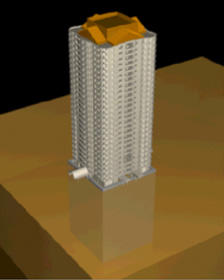
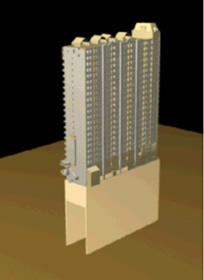
Advantages
Highly functional foundation provides reliable and firm support for the building, ensuring safety against ground subsidence and earthquakesIt will extend the life of the building and improve the value of the assets.
It can be made into a foundation with equivalent performance and better cost performance
Underground composite wall method (TO-SCW method)
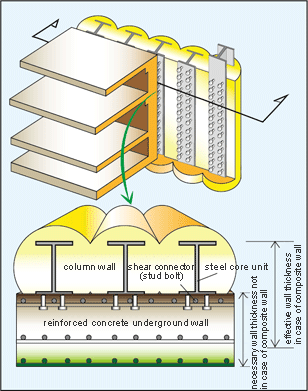
The underground composite wall method combines the steel material used for earth retaining during excavation work with the underground wall of reinforced concrete to resist earth pressure and water pressure as a composite wall
This method is excellent in cost performance, and at the same time enables the effective use of resources, which leads to a reduction in environmental impact.
To date, we have accumulated a great deal of experience and know-how and have been recognized by Center for Better Living as a reputation method.
This method is excellent in cost performance, and at the same time enables the effective use of resources, which leads to a reduction in environmental impact.
To date, we have accumulated a great deal of experience and know-how and have been recognized by Center for Better Living as a reputation method.
Soil-cement improved body method (TO-PSP II method)
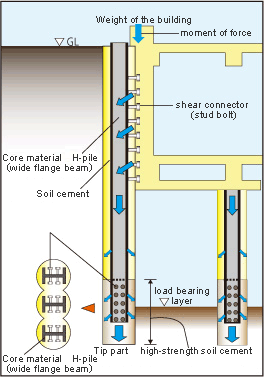
The soil-cement improved body method is also used as a main ground improvement body to support a building with a quadrant retaining wall. Its performance has been confirmed through demonstration experiments.
It excels in cost performance and reduces environmental impact.
It is recognized by General Building Research Corporation of Japan (GBRC) as a method for obtaining technical certification. (No. 02-22, 改2)
It excels in cost performance and reduces environmental impact.
It is recognized by General Building Research Corporation of Japan (GBRC) as a method for obtaining technical certification. (No. 02-22, 改2)
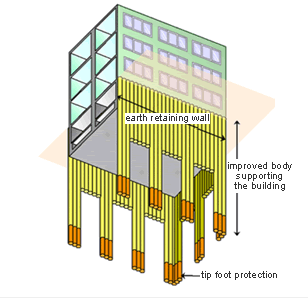
Schematic Diagram of Soil Cement
Improved Body Method
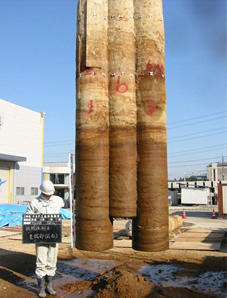
Ground / foundation analysis technology
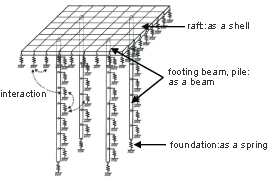
Piled raft analysis model
We offer an analysis program that enables us to visualize the behavior of invisible ground and its internal structure and simulate various phenomena.
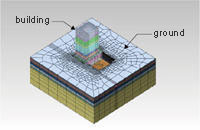
Prediction of ground displacement
and impact on proximity
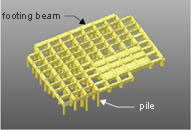
Stress analysis of foundation structure
Quality Control Technology
By combining various quality control tests, quality control of the improved ground will be made more reliable. At the construction ground to support the construction machine, in-situ tests are conducted to confirm the stability of the heavy machine.
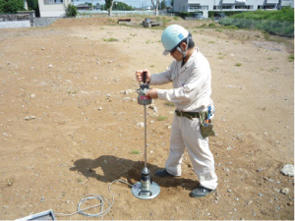
doing Rapid Plate Loading Test
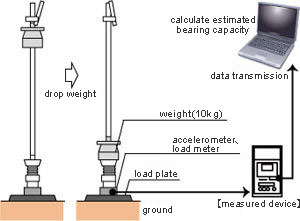
outline of Rapid Plate Loading Test
Control on Construction Ground Bearing Capacity
As a measure to prevent heavy machinery from tipping over, we will carry out a rapid plate loading test that can be easily carried out at site to monitor the bearing capacity of the construction ground.Quality Control for the Improved Ground Under the Soil
It is possible to improve the quality (dispersion) management of the improved ground by combining the plate loading test with the rapid plate loading test.CapTen Pile Method (Half-fixed Jointing Pile Head Method)
The CapTen Pile (CTP) method realizes a rational pile design because the stress at the time of earthquake generated at the pile top is reduced by using half-fixed jointing* between the pile and foundation.※Half-fixed jointing: This refers to the joint state between a rigid joint in which members are rigidly integrated with each other and a pin joint that can rotate freely.
Foundation method that is safe and contributes to the reduction of environmental impact
(1) Reduction of pile diameter, (2) reduction of foundation beams size, and (3) reduction of excavated soil volume will contribute to cost reduction, shortening of time, and reduction of environmental load.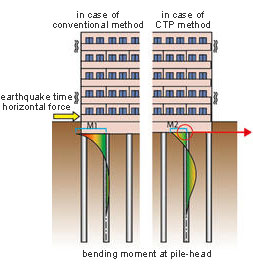
Pile bending moment distribution
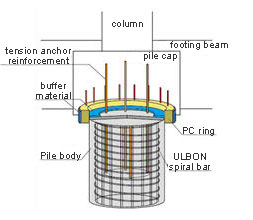
CapTen Pile Method
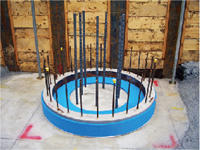
Pile head joint
To acquire ratings and register NETIS
The Building Center of JapanBCJ Rating-FD0230-01,-02
Ministry of Land, Infrastructure, Transport and Tourism (MLIT) New Technology Information System
NETIS register number KT-100082
SY Method
Overview
The SY method is a new cast-in-place belled concrete pile method, that can obtain large bearing capacity by enlarging the diameter of the bottom part by more than twice the diameter of the shaft part (up to 4.84 times the area of the enlarged bottom part).Comparison among straight piles, conventional expanded piles and SY piles (example: expanded diameter φ2300mm)
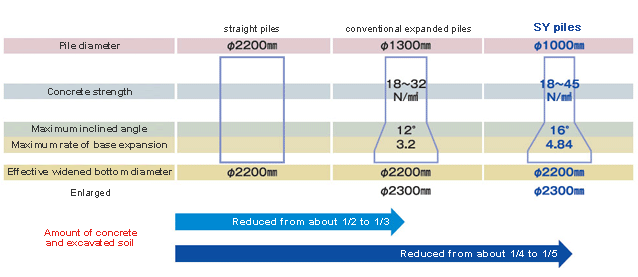
By excavation tests at 20°, exceeding the SY method's maximum inclination angle of 16°, confirm reliable safety
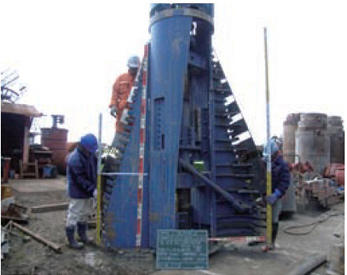
Bucket modified for tilt angle of 20° (SY-1023 bucket)
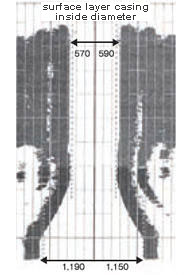
Results of ultrasonic pore wall measurement
(after 18 hours elapsed with 20° tilt angle)
Numerical analysis of SY method
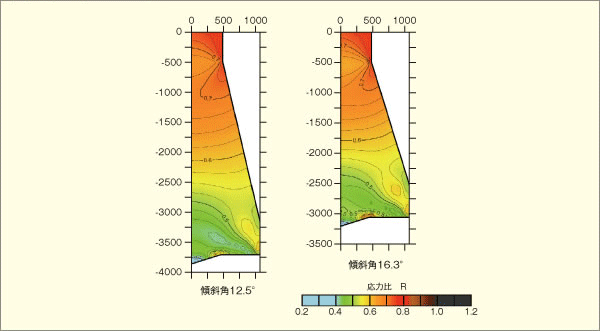 Analysis results (stress ratio distribution)
Analysis results (stress ratio distribution)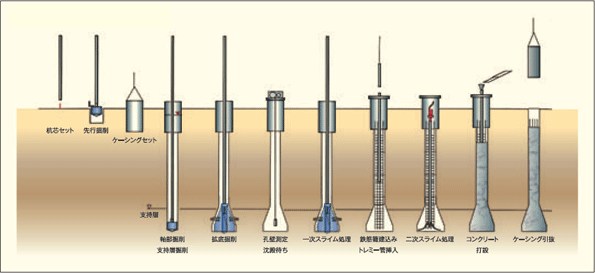 Earth Drill Method Construction Procedure
Earth Drill Method Construction Procedure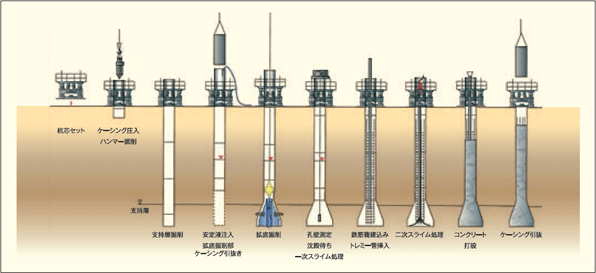 All-casing method construction procedure
All-casing method construction procedure